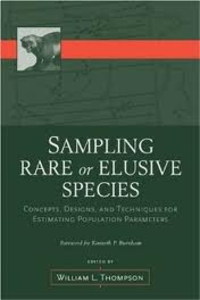Separating components of detection probability in abundance estimation: an overview with diverse examples
Pollock, Kenneth H., Marsh, Helene , Bailey, Larissa L., Farnsworth, George L., Simons, Theodore R., and Alldredge, Mathew W. (2004) Separating components of detection probability in abundance estimation: an overview with diverse examples. In: Thompson, William L., (ed.) Sampling Rare or Elusive Species: concepts, designs, and techniques for estimating population parameters. Island Press, Washington, DC, USA, pp. 43-58.
|
PDF (Published Version)
- Published Version
Restricted to Repository staff only |
||
![[img]](https://researchonline.jcu.edu.au/7450/2.hassmallThumbnailVersion/7450_%26_14411_sampling_rare_or_elusive_species_2004.jpg)
|
Image (JPEG) (Front Cover)
- Cover Image
Download (6kB) |
Abstract
[Extract] Estimation of population abundance of rare and elusive species critically depends on the estimation of detection probability under a particular sampling method. If we ignore the issue of animals not being available, then we obtain an estimate of the size of the available component of the population rather than the total population size. The available component may be only a small portion of the total population. In addition, this component may vary with time and with important auxiliary variables in ways that are so complex that it is unsatisfactory for monitoring the population (see Chapter 4). Animals have to be "available" to a sampling method to be detected. In many animal populations not all animals are available to be captured using a particular sampling method. There may be many reasons for this. For example, in an aerial survey of dugongs (sea cows) off the coast of Australia, some dugongs may be underwater and invisible to the observers searching for them in the aircraft. Even if animals are available, they still have to be detected. This perception process is also uncertain, so, for example, if a dugong is on the surface of the water, observers in the aircraft may still miss it. In this chapter we consider in detail a model for detection probability that accounts for the processes of availability and perception. Methodology for estimating these two components of detection probability is illustrated with three diverse examples involving aerial surveys of marine mammals (dugongs), point counts of terrestrial birds, and capture-recapture studies of terrestrial salamanders. The statistical methodology used in the three examples is very different. We will use the dugong survey as a first example of a solution to a general problem of lack of availability (Marsh and Sinclair 1989; Pollock et al.in press). We then will show that very similar conceptual problems arise in many other settings and biometricians are now seeking solutions to them.
Two other problems we consider are (1) estimation of density of birds based on point counts in which birds are detected by their calls but birds do not always call (i.e., they are unavailable for auditory detection; Farnsworth et al. 2002); and (2) population estimation of terrestrial salamanders, which presents a similar conceptual and practical problem 'because sdamanders may be underground where they cannot be counted or captured (i.e., they are physically unavailable to capture because they are not present on the surface; Bailey et al. 2004a,b). Many formulations ignore the unavailable part of the population, but doing so may be unsatisfactory unless this component is a very small and constant part of the population.
| Item ID: | 7450 |
|---|---|
| Item Type: | Book Chapter (Research - B1) |
| ISBN: | 978-1-55963-450-2 |
| Keywords: | abundance estimation; detection probability; distribution models |
| Related URLs: | |
| Date Deposited: | 07 Jan 2010 04:03 |
| FoR Codes: | 05 ENVIRONMENTAL SCIENCES > 0599 Other Environmental Sciences > 059999 Environmental Sciences not elsewhere classified @ 100% |
| SEO Codes: | 97 EXPANDING KNOWLEDGE > 970106 Expanding Knowledge in the Biological Sciences @ 100% |
| Downloads: |
Total: 325 Last 12 Months: 4 |
| More Statistics |



